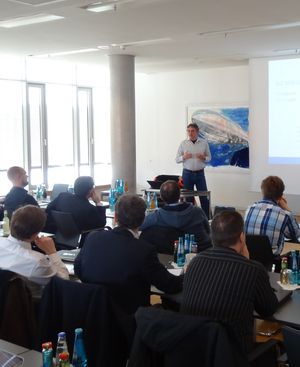KANBrief 4/16

Are those who write the text of standards and set out the rules always sufficiently acquainted with the situation on the ground? In order to gain an impression of whether certain requirements for visibility on earthmoving machinery are even realistic and suitable for implementation, representatives from the market surveillance authorities and standards developers spent a day together in a company, where they examined a number of different machines.
On mobile machines, travel movements constitute the second most common cause of accidents, after the lifting of loads. Collisions with persons are frequently caused by inadequate visibility. Besides industrial trucks, earthmoving machines are a particularly frequent source of accidents, owing to the nature of their use. According to studies conducted by the INRS (Studies ND 2318 (pdf, in french) and ND 2345 (pdf, in french) around a third of the accidents could be prevented or their severity substantially reduced if direct visibility were improved.
The European market surveillance authorities became aware of the large number of accidents and concluded that the ISO 5006 standard governing the operator's field of view on earthmoving machinery no longer reflected the state of the art. In 2013, the European Commission therefore withdrew the presumption of conformity with regard to this aspect for EN 474-1 (Earth-moving machinery – Safety – Part 1: General requirements), which governs the safety of earthmoving machinery and makes reference to ISO 5006 with regard to visibility.
This presented the market surveillance authorities with the question of what concrete criteria they should use for assessing visibility. The Task Force on Earthmoving Machinery of the Administrative Coordination group of the market surveillance authorities (ADCO) listed five criteria that must be met in order for visibility to be considered adequate (See KANBrief 4/14). Standards developers took up these points, but in some areas also discussed possible alternatives.
Better communication – but how?
During coordination between the standards committee and ADCO, it became clear that both sides would benefit from considering the issue and possible solutions by examining real-case examples. On the initiative of the ADCO Task Force and with the support of BG BAU (German Social Accident Insurance Institution for the building trade), a meeting was held in March 2015 at the premises of an earthmoving machinery importer in Germany. Representatives were present from individual manufacturers, the European construction machinery manufacturer's body (CECE), occupational safety and health institutions, and the Member States represented in the ADCO Task force on Earthmoving Machinery.
Charles Crowell, Chairman of the ISO working group, reported on the progress of revision of ISO 5006. Kurt Hey (BG BAU) presented the method approved in 2006: in this method, a test body must be visible at all points 1 m from the machine; in addition, the permissible blind spots are tested on a circle with a radius of 12 m from the driving position.
First-hand experience of machines
Measurements of the field of view were performed in an outdoor area on a hydraulic tracked excavator. Representatives of the Member States and of the European Trade Union Institute (ETUI) also tried out these measurements themselves. In addition, an automatic measurement and recording system fitted to a roadsweeper was demonstrated. This system could also be fitted to other machine types.
The participants had the opportunity to examine the benefits of equipment such as rear-view mirrors and cameras more closely on a range of machines. Various machines including a shovel loader, a skid-steer loader, a dumper, a double-drum vibrating road roller, hydraulic excavators of various sizes and bulldozers were available for this purpose.
Finally, two generations of machine were compared which illustrated the difficulties of implementing the latest TIER 4 emissions regulations. These regulations require larger engines and exhaust systems that in some cases negate the improvements made to visibility.
Lively discussion ensued, for example of the possibility of extending the requirements in standards such that the entire area between the 1 m and 12 m radii is considered. This would eliminate blind spots more effectively.
An example for others to follow
The event was well received, since it provided insights into the diversity of the machines and influencing factors, and promoted mutual understanding between all the parties involved. We are sure to make use of this approach again in the future, and are of the opinion that other standards committees could also benefit from it.
Pierre Picart
Chair of the ADCO Task Force on Earthmoving Machinery
French Ministry for Labour
pierre.picart@dgt.travail.gouv.fr